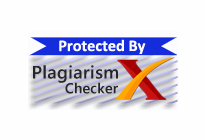Analisis Hubungan Kompensasi Finansial dan Non Finansial Terhadap Motivasi Kerja Karyawan PDAM Tirta Bening Pati.
Abstract
The purpose of this study was to determine how much financial compensation affects Employee Work Motivation at PDAM Tirta Bening Pati and to find out how much non- financial compensation affects Employee Work Motivation at PDAM Tirta Bening Pati. Based on previous research by Ulfah (2016) and Sahari ( 2016) argues that compensation is very important. Because through compensation for employees is an effort to improve performance, passion and work motivation in employees, the hypothesis in this study is: Financial compensation affects employee work motivation at PDAM Tirta Bening Pati, non-financial compensation affects employee work motivation in PDAM Tirta Bening Pati
The population in this study were all employees of PDAM Tirta Bening Pati with a total of 190 people. The sample is 66 respondents. The test used is multiple linear regression analysis, t test, F test and the coefficient of determination. Financial compensation has a positive and significant effect on employee motivation. Non-financial compensation has a positive and significant effect on employee motivation. The work motivation of the employees of PDAM Tirta Bening Pati can be maintained or improved so that the work that is the responsibility of the employees can be carried out properly.
Downloads
The use of the article will be governed by the Creative Commons Attribution license as currently displayed on Creative Commons Attribution 4.0 International License.
Author’s Warranties
The author warrants that the article is original, written by stated author(s), has not been published before, contains no unlawful statements, does not infringe the rights of others, is subject to copyright that is vested exclusively in the author and free of any third party rights, and that any necessary written permissions to quote from other sources have been obtained by the author(s).
User Rights
JSS's spirit is to disseminate articles published are as free as possible. Under the Creative Commons license, JSS permits users to copy, distribute, display, and perform the work. Users will also need to attribute authors and JSS on distributing works in the journal.
Rights of Authors
Authors retain all their rights to the published works, such as (but not limited to) the following rights;
- Copyright and other proprietary rights relating to the article, such as patent rights,
- The right to use the substance of the article in own future works, including lectures and books,
- The right to reproduce the article for own purposes,
- The right to self-archive the article,
- The right to enter into separate, additional contractual arrangements for distribution of the article's published version (e.g., post it to an institutional repository or publish it in a book), with an acknowledgment of its initial publication in this journal (Jurnal STIE SEMARANG).
Co-Authorship
If the article was jointly prepared by other authors, any authors submitting the manuscript warrants that he/she has been authorized by all co-authors to be agreed on this copyright and license notice (agreement) on their behalf, and agrees to inform his/her co-authors of the terms of this policy. JSS will not be held liable for anything that may arise due to the author(s) internal dispute. JSS will only communicate with the corresponding author.
Royalties
This agreement entitles the author to no royalties or other fees. To such extent as legally permissible, the author waives his or her right to collect royalties relative to the article in respect of any use of the article by JSS.
Miscellaneous
JSS will publish the article (or have it published) in the journal if the article’s editorial process is successfully completed. JSS's editors may modify the article to a style of punctuation, spelling, capitalization, referencing and usage that deems appropriate. The author acknowledges that the article may be published so that it will be publicly accessible and such access will be free of charge for the readers as mentioned in point 3.





.png)





